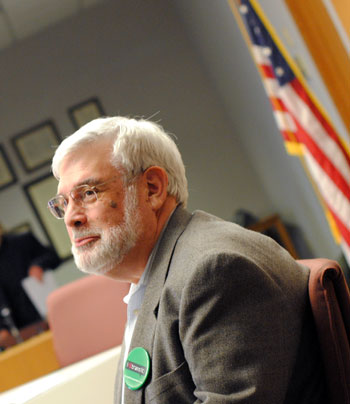AATA Speaks Volumes on Draft Transit Plan
Ann Arbor Transportation Authority board meeting (April 21, 2011): In its one piece of formal business, the board of the Ann Arbor Transportation Authority approved a resolution to disseminate the draft of a countywide transportation master plan, which it has been developing over the last year. At least five public meetings will be held in May to introduce the plan to the community.

Ann Arbor Transportation Authority board member Charles Griffith flips through his copy of the draft transportation master plan. (Photos by the writer.)
The plan currently comprises two separate volumes – one outlining a vision and the other outlining how that vision would be implemented.
[.pdf of draft "Volume 1: A Transit Vision for Washtenaw County"] [.pdf of draft "Volume 2: Transit Master Plan Implementation Strategy"]
A third volume, on funding options, is forthcoming. It will not include a detailed discussion of governance. But the tax revenue portion of future funding will depend in part on the future governance structure of whatever agency is responsible for public transit in Ann Arbor and the rest of the county. Options for future governance include a countywide authority, which could eventually supplant the AATA as the agency responsible for public transit. On Thursday, the board received an update from CEO Michael Ford on conversations he’s been having, and will continue to have, with elected officials about the governance of a countywide authority.
In general concept, a countywide transit authority could first be formed and exist simultaneously with the AATA, but with no source of tax revenue. At some point, probably not this year, a millage proposal to support the countywide transit authority would be put in front of voters across the county. And if that millage were to succeed, the AATA’s assets would be folded into the new countywide transit authority.
In other work at Thursday’s meeting, the board held a public hearing on its planned federal program of projects.
The board also entertained the usual range of reports from its committees. Highlights included the fact that ridership has increased in the last month slightly compared to last year, and cost per service hour is better than what has been budgeted. The board also received an update on efforts to improve its real-time information to riders by working with its current software vendor, Trapeze. [Full Story]




